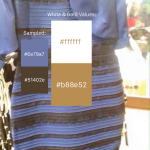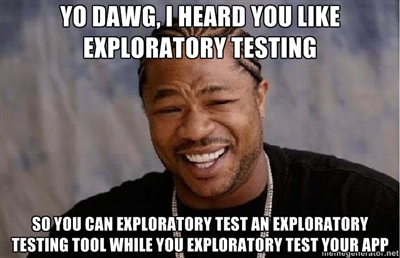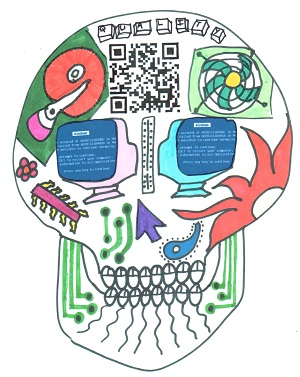A funny thing happened today at work. I found out that some of my colleagues literally see things differently. Many of us found ourselves surprised by what others perceived to be true about something as simple as an image. We were swept up in #dressgate: a raging internet controversy about a photo of a dress and its colors.
I’m on Team Blue and Black. However, I wanted to see how the other half lives. I tried various ways to see white and gold: viewing the image on different devices, changing screen brightness, angling the screen, walking around in different ambient light. The various experiments all produced the same results. Trusting my perceptions, I could not give any credence to the perspective that the dress was a different pair of colors, despite seeing many online posts to that effect.
I mentioned this to my team at work, only to discover that there were others who had no idea anyone disagreed with them. As a member of Team White and Gold, my team’s designer was surprised to hear there was a Team Blue and Black – as surprised as I was. 🙂 I couldn’t help wondering whether she was expecting a covert camera to emerge as part of some elaborate prank.
Fortunately, working with designers means having deeper organizational knowledge about colors. By the time lunch rolled around, another colleague had created an online tool for experimentation with the image to see for ourselves how image manipulation would change perception. Another designer mentioned that he had sampled the original image to identify the colors and then created swatches of the colors perceived by others to overlay the image in order to show both positions contrasted with each other, explaining about the impact of shadows and subtle colorblindness.
Then, he suggested another avenue of investigation: flash blindness. In flash blindness, a bright light bleaches (oversaturates) the retinal pigment resulting in sudden vision loss that doesn’t immediately return to normal, but it usually wears off gradually. So my team devised an experiment to expose our designer’s eyes to a bright white lightsource: a blank page on a screen. When she quickly switched from the bright white background to the original dress image, she was able to see blue and black coloration. However, after a few moments, when she glanced at the dress image again, her retinas had recovered and she saw the original white and gold pigments. This was consistent with reports from other online posters who mentioned scrolling down the page and then being able to see different colors. This transient state seemed to be a source of great consternation and some panic.
While this was a fun way to spend our lunch hour, it was also a great opportunity to practice some of the problem-solving skills I learned at last year’s Problem Solving Leadership workshop:
- Experimenting to gather information – Although I was not able to see the white and gold version of the dress without manipulating the image, I learned new ways that didn’t work.
- Perceptions, What’s true for you – I felt quite certain about the stability my own perceptions after looking at them from various angles
- Watch how other people are behaving – While I thought it was quite surprising that many others had such completely different perceptions, I did not assume they were wrong just because I couldn’t observe the same things.
- Be cautious about not noticing – I gave others the benefit of the doubt knowing that I can bias myself to ignore information sometimes.
- How to take in info – I looked for a variety of sources of information about the disparate points of view to obtain a balanced set of data.
- Resisting information – I paid attention to reports of heated arguments between people from the different viewpoints, noticing the emotion involved in what seemed like a purely factual question.
- Motives (test interpretation, seek intent) – I asked two observers from Team White and Gold questions since they could see what I could not
- Reading minds – I tired not to assume that anyone was punking me or simply being ornery but instead was open to the possibility of being wrong.
- Style vs intent (make more congruent) – Rather than trying to convince anyone of my point of view, I listened to their experiences and observed their learning process.
- Social structures – It was interesting to see that even within the design group there were opposing assessments of the information. I also saw how team members collaborated rather than confronted each other when trying to understand where each was coming from.
- How do you get people to recognize what you saw? – I waited for an opportunity for them to experience it directly and shared the information that I had so the other team members could judge for themselves, now that they had more to work data
- Show you care by speaking up – I could have ignored people who didn’t agree with me, dismissing their viewpoint as simply wrong. However, engaging in dialogue was a great team-building experience and helped to establish more common understanding.
- Reactions – By giving myself a charter of observing others’ behavior, thought processes, and evidence, I was better able to empathize with what was a shocking experience from their point of view.
- Eyes open! Use your senses – I took suggestions from the designers about resources for assessing color perception and did not assume that I could gather unbiased information. In the end, I know more about myself than I did when this silly discussion started.
- Learn from others – I certainly know more about color, perception, troubleshooting, experimentation, and these particular colleagues than I did before I posted the question “What color is this dress?” so I call today a win. 🙂
- Aaaaand I couldn’t help trolling just a little bit by “wearing the colors” today…





 There comes a time in every woman’s life when her friends announce their engagements. The joy she feels about the momentous occasion of the wedding carries her through the mundane details of choosing what to wear and shopping for a gift to wish the newlyweds well. With wedding showers appearing on the horizon, I knew it was time to go back into the fray of shopping at the mall.
There comes a time in every woman’s life when her friends announce their engagements. The joy she feels about the momentous occasion of the wedding carries her through the mundane details of choosing what to wear and shopping for a gift to wish the newlyweds well. With wedding showers appearing on the horizon, I knew it was time to go back into the fray of shopping at the mall.


